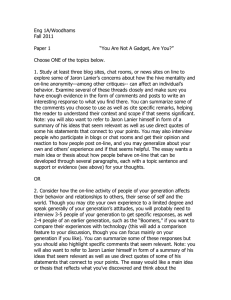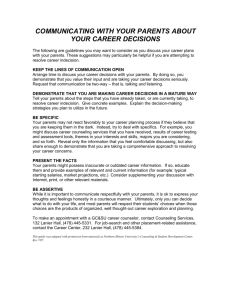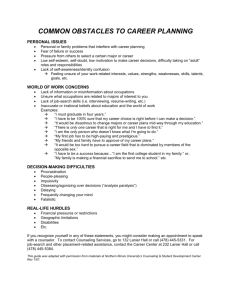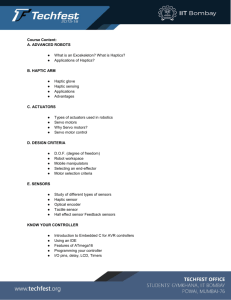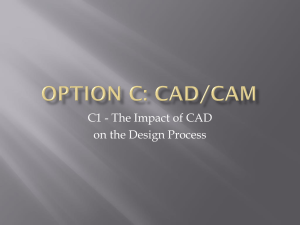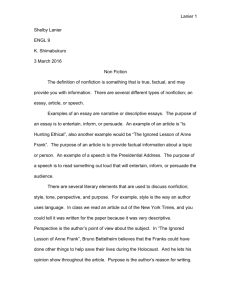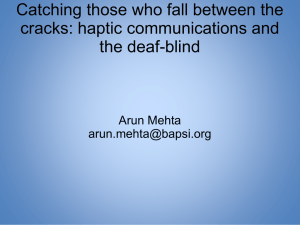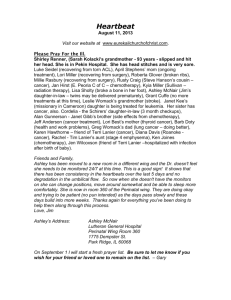Behind the scenes of VR
advertisement
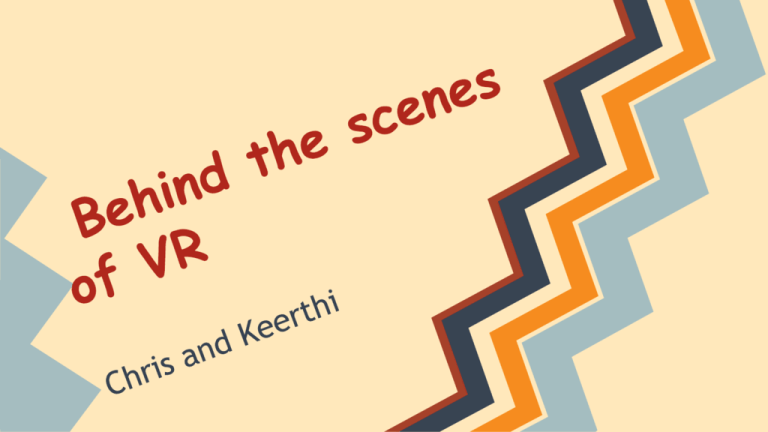
Genesis of Virtual Reality • • • Virtual reality was primarily known as Virtual World While working with Ivan Sutherland, Jaron Lanier thought that the term Virtual Reality is more of an accurate term than Virtual World. This is because people are treating this view as their reality. What is VR? • Webster defined as: “an artificial environment which is • Usually: computer generated 3D that a user can interact experienced through sensory stimuli (as sights and sounds) provided by a computer and in which one's actions partially determine what happens in the environment” with o User normally wears glasses or a head-mounted display (HMD) o Recently haptic devices provide feedback First Forms of Virtual Reality ● The first forms of Virtual Reality were created during the 1860’s in the form of panoramic 360° murals. Baldassare Peruzzi Sala Delle Prospettive The sensorama! ● During the 1950’s Morton Heilig wrote of an “experience theater” that used sight, smell, touch, and sound. He created a prototype of this vision and called it the sensorama. First headset ● In 1968, Ivan Sutherland and Bob Sproull created the first virtual and augmented reality head-mounted display system. This system was so heavy that it had to be suspended from the ceiling. More Amazing VR Developments • • • Aspen Movie Map of 1977 created by MIT is also one of the hypermedia and Virtual Reality systems. During the 1980’s the term “Virtual Reality” was coined and popularized by Jaron Lanier. In 1991, Antonio Medina, a MIT graduate and NASA Scientist, designed a virtual reality system to “drive” Mars rovers from Earth. Founding Father-Jaron Lanier • • • • Jaron Lanier is a computer scientist, composer, visual artist, and author. Coined and popularized the term “Virtual Reality” during the early 1980’s. IEEE Virtual Reality Career Award in 2009 Named one of TIME's 100 most influential people in 2010. Feeling overwhelmed? Benefits of VR • • • • • Currently used in many fields to assist workers o used in military, fashion, business, engineering, health care, architecture, and much more. Used to assist people with phobias and other disorders like PTSD Entertainment in video games Immediate feedback Haptic Responses VR in military training • • • • Currently used by United States military in both training and recovery from war. Soldiers are put into virtual environments to prepare for situations in war. Have controller that acts similar to a weapon In the air force, it is most used to train pilots o Joystick provides haptic feedback from damages to the plane and even the effect of weather http://www.youtube.com/watch?v=NND7Hk5fYdI VR in education • Tucson Arizona has an entire class that makes virtual reality worlds. http://www.cbsnews.com/8301-18563_162-57589958/innovative-ariz-class-turns-students-dreams-into-reality/ • • • • In East Hartford, Connecticut it is used to simulate work on virtual cars. Helps children comprehend more about the real world. Saves time and money. Some schools do not believe that it is worth it. VR in health • • Healthcare is one of the biggest adopters of virtual reality which encompasses surgery simulation, phobia treatment, robotic surgery and skills training One of the advantages of this technology is that it allows healthcare professionals to learn new skills as well as refresh existing ones in a safe environment. Plus it allows this without causing any danger to the patients Virtual Reality Therapy • Burn patients o o o University of Washington distract them from pain more real the virtual world, less pain Virtual Reality Therapy Cont. • PTSD/Phobias Used Spider world to help cure arachnophobia Recreates events to help people deal with them Fort Bragg is testing out how VR can help marines with PTSD These virtual worlds are made very realistic to help emotionally handle the situation. o Seat vibrates and controller is like a gun o $30,000-$40,000 o o o o Helping you forget this as well Costs of VR • • • Some people believe that advanced virtual reality will cut back on face-to-face interaction Reliability on virtual training Actual cost for households o (HMD) $599 $585 o Haptic Glove $750 o Head trackers $325 o software o http://www.vrealities.com/ Data Gloves, Sensors, Gloves covered in sensors allow more freedom in movement • • • o possibility outside of gaming ASL translation allows for haptic feedback and more involvement in virtual world HMD’s • • • • • • • needed for virtual reality measures head movement recent developments in Oculus Rift farther field of vision adjusted lenses/ magnification $300 Expected around December this year. Ethical issues of VR • • • • VR games with violence and guns influencing the player distinguishing reality from virtual reality becoming more difficult influence on younger users addiction to VR more than addiction to normal video games Making VR • • • • • • most companies focusing on PC software texturing objects to make them appear more real frame-rate needs to be about 25 frames per second stereo vision often used to appear more realistic so much goes into making the world realistic like lighting, definition, and even computer speed much is still in the early stages of perfecting Future of VR • Nanobots in possibly 25 years o • • • o put into the body and interact with neurons to make experience completely real lots of doubt about this process Household use if price goes down More realistic environments More applications in training Conclusion • • • • VR is still far from being perfected it has many uses and has been around for quite a few years becoming more innovative in its uses cost saving once obtained, but very costly to get May the odds be ever in your favor
